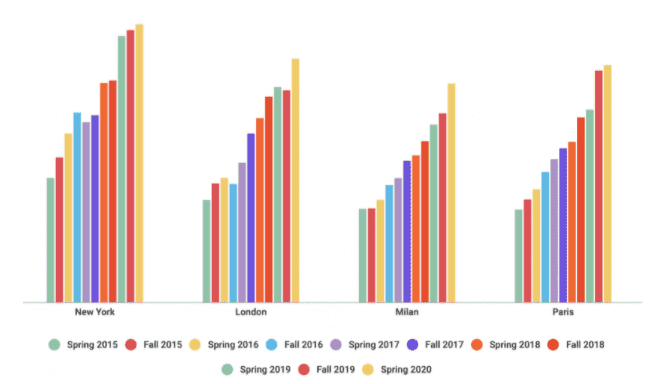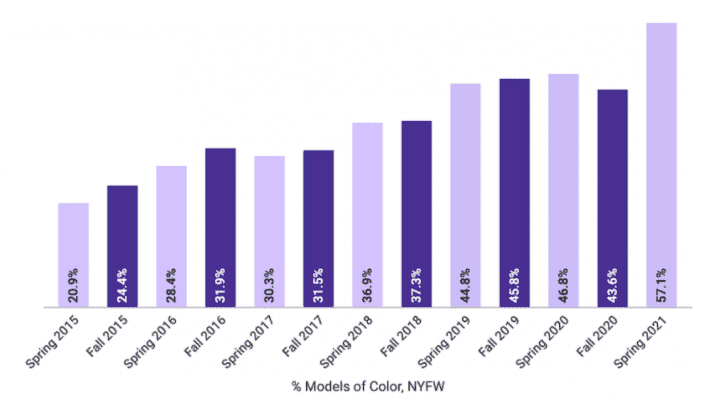There has always been a lot of speculation for social injustice within the fashion industry. In 2014, only 20.9 percent of models on the Spring 2015 runway at New York Fashion Week were of colour.
Diversity and inclusion issues have drawn a great deal of attention to the fashion industry in previous years. Since 2014, Fashion creatives have worked at ensuring their models on the catwalk and in campaigns can be a realistic and accurate representation of all women around the world.
Barbara Kennedy-Brown, founder of The Fashion Minority Alliance and who sits on the Diversity and Inclusion Steering Committee launched by The British Fashion Council, says; “It is hugely important that the industry has a representation of diversity and PoC within their presentations, be that campaigns, catwalks, brand ambassadors and influencers but this really boils down to image and brand positioning. What is needed is for the people who are making the decisions on the boards of these brands to also be diverse and inclusive as that is the way that representation will not be purely at a superficial level.”
Back in October 2019, The Fashion Spot announced in their diversity report that the Spring 2020 season was the most diverse on the catwalk since 2015, when they began recording figures, with 41.5 per cent of models being people of colour.This was the most diverse fashion season in all four fashion capitals.

Image: www.thefashionspot.com
Although only a small margin, by the time the Fall 2020 season came around only 40.6% of models cast were of colour. Despite this decrease, the Fall 2020 shows still ranked as the second most inclusive and diverse season.
During the Covid-19 pandemic period, when gatherings of more than six people were forbidden, protests for Black Lives Matter took place around the UK. This came after George Floyd, a 46-year-old African- American man, was killed by police officers while under arrest in the US.
Barbara explained; “With BLM, particularly as we were in UK lockdown, there was a captive audience and the messaging resonated with so many, not only through the tragic and appalling death of George Floyd, but wider issues that the community face and I think it has helped hold a mirror up to so many industries which can be seen as the perfect opportunity to address the issues and change the narrative. My work with the Fashion Minority Alliance sees us speak to a lot of brands who are in the process of, or already have, engaging with Diversity and Inclusion officers both internally and externally who we hope will ensure that the necessary changes are made.
“There has been a lot of brand noise around BLM and this was perhaps best seen via social media. Brands’ grids, that had previously been ‘all thin white,’ were suddenly peppered with diverse and black models, with quotes of solidarity and diversity and the black out. Whilst this is important with visibility, the Black and Minority communities would benefit from more genuine consideration within the brand marketing plans, this is also hugely important for the brands as they would see a far bigger audience of consumer which ultimately increases sales and profits.”
Undoubtably, due to the global outbreak of coronavirus, the SS21 was set to run a little different. Many fashion houses chose not take part in traditional runways and presented their collections using alternative methods such as look books and online video. However, The Fashion Point broadcasted that shows at New York Fashion Week saw over half of models cast to women of colour, 57.1 percent of 287 models at 48 shows to be exact.

Image: www.thefashionspot.com
Barbara further adds; “We have heard various examples of ‘black is in fashion’ and this is nothing new. When you look at ‘trends’ they have both historically and modernly referenced street culture, or ‘black’ culture with many of the big houses producing collections full of streetwear. What is important now is not only which models are used to present the collections, but acknowledging where these designs originated and celebrating this, which can only be achieved with inclusivity and diversity at all levels.”
Fashion curator and historian, Pamela Golbin, told WWD; “Fashion isn’t about a formula but does react to the needs of a given period.” Could the dramatic increase of inclusion of women of colour in the Spring 2021 shows be a direct response to Black Lives Matter? If so, we must ensure this becomes a movement and not just temporary appeasement.
Follow us on Twitter @Fashion_North
